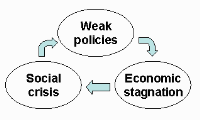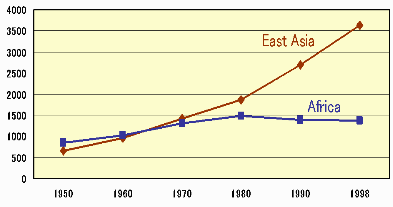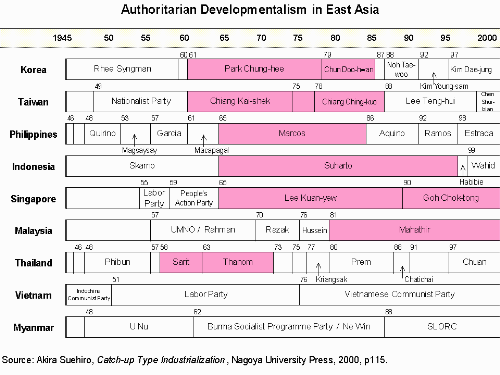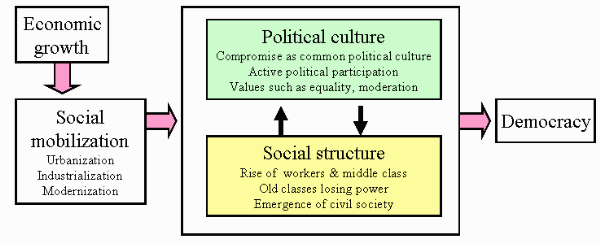4. Leadership and Political
Regime
1. The crucial role of leadership
Leadership with
proper vision and decisive action is the most important driver of
organizational change. This is true for any organization, from the micro level such as a firm
or a committee, to the macro level such as a country or even the global community.
Although some changes are realized through popular pressure or effort
by middle-ranking technocrats, bold policy shifts or administrative
reforms are usually accomplished under strong leadership.
We are particularly interested in the quality of the top leader of the state such as the president or
the prime minister. In addition, effective leadership is desirable at any level,
including ministers, committee chairs, department heads, etc. These leaders
determine the effectiveness of organizations under their supervision.
There are many "strong" national leaders in the world, but only a few of them succeed
in promoting development. This is because strong power is only a necessary,
but not sufficient, condition for effective leadership. Good leaders are not
just strong.
First and foremost, the personal character and ability of the top leader is
crucial. A strong national leader must at the same time be economically
literate. He or she must have the keen sense of what works and what does not
in accelerating development. PhD in economics is not needed, but instinct to
select right policies and good people is essential. When that instinct is
combined with strong determination and quick action, development begins. In
contrast, a strong leader who is economically illiterate only causes stagnation
and confusion.
Second, a political regime that enables a leader to execute necessary
policies and reforms is needed. However, this requirement is secondary, since a
truly strong, economically literate leader can build such a regime if it does not
already exist. In this sense, leadership is primary, since it can change all other conditions and relations, including
the political regime and five relations we have proposed to look at.
2. State typology
Robert Wade (London School of Economics), a political scientist specializing
in Taiwan, asks what kind of government is needed for industrial policy to work.
He classifies developing countries into three types (Wade, 2006):
Neopatrimonial type--in this type of state, there is no clear
separation between the public realm and the private realm. State leaders and
officials see the state's authority and resources as their own. Budget,
investment projects, ODA, state companies, etc. are considered to be instruments
for increasing the personal profits of those in power as well as their relatives,
friends and followers. Prof. Wade says that many
states in Sub-Saharan Africa, Middle East and Central Asia belong to this type.
Fragmented-multiclass type--in this state, public and private realms
are separated, and policies are conducted for the benefit of the nation rather than for the ruling few. However, state authority is fragmented
and the social base (supporter base) is plural, including capitalists, workers,
farmers, military, landowners, etc. According to Prof. Wade, India, most of Latin America, and some Southeast Asian countries
belong to this group. (This type of state is normally called "populism" or "soft
state.")
Cohesive-capitalist type--this state is characterized by concentrated
state authority at the top; a narrow supporter base comprising of capitalists
only, who interact intensely with the state; use of concentrated power to discipline
the rest of society including workers; deep penetration of state power into all rural and
urban areas; nationalistic or anti-communist ideology to keep the society as
one; and restriction of political participation. (This type of state is normally
called "developmental state" or "hard state.")
Using this classification, Prof. Wade argues as follows. Whether industrial policy works
or not depends on the type of state. In a neopatrimonial state, any industry
policy fails, so it should not be attempted. The IMF-World Bank prescription
of bold liberalization and provision of the level playing field is most suitable for such a
state. By contrast, industrial policy is useful for states of the other two types. For the fragmented-multiclass type, "grass roots" industrial policies
for upgrading technology, management and human resources, such as industrial
extension service and worker training programs, should be implemented. These do not require huge capital or
a sophisticated organization. For the cohesive-capitalist type, more aggressive
and selective
industrial policies, like those adopted by Japan and Korea in the past, may also
be possible.
However, Prof. Wade's classification is a static one. The big question is how a
country can transform itself from the first type to the second or third type--if
that is deemed desirable.
3. East Asia's authoritarian developmentalism
 Developing countries are often
trapped in policy dilemma. There are usually many weaknesses in the private sector, such
as low technology, insufficient labor quality, weak management, fund shortage,
lack of trust and entrepreneurship, unreliable contracts, primitive banking,
etc. The government is expected to solve these problems, but the government
itself faces many problems, such as inefficiency, lack of talent and
information, corruption, bureaucratic formalism and sectionalism, and political pressure.
Low-quality policies cause low growth and social frictions. Policy, economy and
society are trapped in a vicious circle. Huntington-Nelson's technocrat model and populist model,
introduced
earlier, are an example of such dilemma. Only countries that escape this
trap can take off and achieve sustained growth, while others may forever
remain in a state of low development.
Developing countries are often
trapped in policy dilemma. There are usually many weaknesses in the private sector, such
as low technology, insufficient labor quality, weak management, fund shortage,
lack of trust and entrepreneurship, unreliable contracts, primitive banking,
etc. The government is expected to solve these problems, but the government
itself faces many problems, such as inefficiency, lack of talent and
information, corruption, bureaucratic formalism and sectionalism, and political pressure.
Low-quality policies cause low growth and social frictions. Policy, economy and
society are trapped in a vicious circle. Huntington-Nelson's technocrat model and populist model,
introduced
earlier, are an example of such dilemma. Only countries that escape this
trap can take off and achieve sustained growth, while others may forever
remain in a state of low development.
In East Asia, there are many latecomer countries that have achieved (or are
achieving) high growth and rapid industrialization. Japan began to show
remarkable performance as early as the late 19th century. Newly industrializing
economies (NIEs)--Singapore, Hong Kong,
Taiwan and Korea--followed in the late 20th century. At present, a number of ASEAN
countries are experiencing high growth, and China is also catching up very
rapidly. How did these East Asian countries overcome the policy
dilemma mentioned above?
East Asia's successes were not because of good initial conditions. After WW2, most countries in East Asia suffered serious war damage or had to fight a painful war of independence.
The Korean Peninsula and Indochina (Vietnam) were the two places where the Cold War turned
hot. China under Chairman Mao experienced serious human and social damage. In
1950, the average income of East Asia was lower than Africa. But now, no one
doubts the superb economic achievement of East Asia.
|
Per Capita GDP
(in adjusted 1990 dollars) |
 |
| Source: Angus Maddison, The World
Economy: A Millennium Perspective, OECD Development Centre, 2001. |
East Asia's high-performing economies solved the policy dilemma by adopting a political regime which Prof. Toshio Watanabe (Takushoku
University) calls authoritarian developmentalism (also called
developmental state). As argued in Overview,
institutional change can occur in several ways. Authoritarian developmentalism
was installed and managed by
policy, that is, by internal initiative of the central government as deus ex machina.
(The only exception to this was Hong Kong, which adopted laissez-faire
policies and political liberalism to achieve high income.)
Key ingredients of authoritarian developmentalism are as follows.
(1) Powerful and economically literate leader
(2) Development as a supreme national goal and ideology (obsession with
industrialization and export competitiveness, instead of poverty reduction or
people's empowerment)
(3) An elite technocrat group to support the leader in designing and
implementing policies
(4) Political legitimacy derived from successful development
(5) Broad popular support
To be successful, an authoritarian developmentalist
state must implement two
kinds of policies: (i)
developmental policies to accelerate growth, which include development plans
and strategies, education and training, technology, infrastructure, FDI
attraction, finance, etc; and (ii) supplementary policies
to solve the problems arising from rapid growth and social change, such as pollution, congestion,
inequality, corruption, and other social evils. Unless both
policies work, the country cannot stay on the long-term growth track. This
policy mix enabled East Asian countries to avoid social crises which
Huntington and Nelson regarded as inevitable.

East Asia's authoritarian developmentalism often emerged under severe
military threat. South Korea was threatened by North Korea, and Taiwan's
existence was precarious in the presence of Mainland China. Internal political
chaos and ethnic unrest also increased the likelihood of such a regime. Authoritarian
developmentalism was often established through a military coup to replace a
previously weak, ineffective
government. After its establishment, many elements of democracy such as freedom
of speech, free and fair election and the power of parliament were restricted or suspended. For this reason,
the regime is usually criticized by the Western countries as "undemocratic."
Why do we need an "undemocratic" state to execute development? The
reason--which may be convincing or questionable depending on one's viewpoint--is that
rapid economic growth from a low level requires massive and speedy resource
mobilization. The country must build power and transport infrastructure, unify
ethnic and social groups into one nation, attract investment, improve skills and
technology, build new schools and hospitals, crack down on crimes and social
evils, relocate residents, manage internal migration, conduct macro and trade
policies, etc. If broad political participation of all groups is allowed, and if
all policies must be debated in the parliament, it is more democratic but takes
too much time. If a critical mass of policies is not adopted simultaneously, the
country cannot initiate or sustain growth.
The graph below, with pink areas, shows the history of East Asia's authoritarian
developmentalism according to Prof. Akira Suehiro (Tokyo University), an expert
on Thailand. Among
all "dictators," some were very effective in promoting development while
others were not. Despite Prof. Suehiro's nomination, it is quite doubtful if we
should label Philippines' Marcos regime as authoritarian developmentalism. On
the other hand, China is not included here, but if it is, Deng Xiaoping's rule (1978-1997) would surely be counted as
authoritarian developmentalism. Prof. Suehiro does not
consider Vietnam or Myanmar as authoritarian developmental states. Although they
may be authoritarian, they are not sufficiently developmental.

<Click graph to enlarge>
Another important point about authoritarian developmentalism is its
transitional nature. It is not a regime all countries should strive to achieve
as a long-term goal. Rather, it is a short-term regime of convenience lasting
for a few decades, an
instrument for achieving fast growth at a critical moment in the history of a
particular country. Once the desired level of development is attained, it should
be thrown away just like the first-stage booster must be ejected when the rocket
reaches a certain height.
4. Components of democracy
When authoritarian developmentalism is mentioned, there are usually two types
of reaction. The first reaction is acceptance and even a praise of this regime
as an effective tool for latecomer countries. The second
reaction is rejection and abomination, with a strong conviction that democracy
is sacred and should not be sacrificed in the name of development. Generally
speaking,
officials and researchers in East Asia have more favorable views on
authoritarian developmentalism than their Western counterparts. Evaluation is
always sharply divided--that is the general experience of the author when he presented
the idea at OECD (Paris), UNCTAD (Geneva), World Bank (Washington, DC) or ADB
(Hanoi).
Some people are emotionally opposed to any restriction of democracy. Others
think that democracy and economic development are two separate matters.
For example, Prof. Dani Rodrik (Harvard University) states:
"I do not think there is any tradeoff [between economic growth and
democracy]. I do not think the reason democracy is valuable is exclusively or
mostly for economic reasons. Nor do I think any country in the world is poor
enough that it cannot afford to have democracy or better observances of human
rights. I believe that empirical evidence supports that a country does not have
to pay an economic cost or penalty when it makes the transition to democracy. I
do not subscribe to the idea that you need to delay democratization just so that
you can actually have growth or that you can have democracy only when you can
afford it .... I also do not think that democracy is a precondition of economic
growth. I think democracy is good for a whole lot of things. The sooner you can
have it the better. Democracy is a largely different issue than the question of
development in the narrow economic growth sense." (Rodrik, 2006)
To consider this issue more deeply, the concept of democracy should be
divided into several components:
Human rights--freedom, equality, social rights, etc. and the absence
of oppression.
Legitimacy--origin and transition of power must be legal and based on
the will of the majority, without
power seizure by force.
Rule of law--all decisions and actions of the state must be based on
law, not personal discretion of politicians or officials.
Participation--free election, voting right for every citizen,
multi-party system, opposition and interest groups, and decision-making by
majority rule in the parliament.
Public purpose--all policies must be conducted for the benefit of all, not a
few.
Decentralization--localities should have enough authority and budget
to conduct policies, instead of being dictated by the center.
Authoritarian developmentalism restricts some of these components in order to
carry out policies that are regarded as necessary with speed and flexibility.
But not all components need to be suppressed for this purpose.
When the regime is established by a military coup, there is no legitimacy in
the above sense. Instead, an authoritarian developmental state seeks legitimacy
by pursuing public purpose, namely, delivering high economic performance to all.
As for other components of democracy, they are usually restricted, but the
degree of restriction must be moderate and reasonable. For example, some human
rights such as freedom to criticize the government are often restricted to
achieve political stability, but random oppression, torture and execution, or
even ethnic cleansing, at the
whims of a dictator should never be allowed. Under authoritarian
developmentalism, only those restrictions necessary to carry out economic
policies may be tolerated, if at all. Instead of rejecting any deviation from democracy, we
may perhaps ask whether or not the amount of restriction is appropriate and not
excessive.
Another important issue is the exit problem. Watanabe (1995) argues that
authoritarian developmental states will melt away when they succeed in
development. As income rises, social structure and people's attitude change in
the direction which tends to disapprove authoritarianism. This is true, but the
exit may not be so automatic. Strong leaders tend to stay for
a long time, and often continue to cling to power when they are old and no longer
useful. Unlike well-functioning democracy, this regime does not have an internal
mechanism of power transition without causing instability or bloodshed. Thus,
smooth power transition must rely largely on the wisdom and self-control of the
leader himself. In East Asia, exits of authoritarian leaders have been sometimes
smooth and sometimes violent.
The situation is much the same when one political party monopolizes power, be
it the Communist Party or the Liberal Democratic Party. The ruling party, when
it remains in power for several decades, generates a web of beneficiaries and
supporters who resist reforms. As the party's policies, which worked
well initially, become outdated, a fight between reformers and conservatists normally emerges.
5. Democracy as an evolving process: the Korean experience
Today, South Korea (Republic of Korea) is a country that can competitively produce high-tech products such as cars and
consumer electronics. But half a century ago, people did not think that Korea
had any future. It was a colony of Japan until 1945. The Korean War (1950-53) devastated
and divided the country. In comparison with North Korea which had heavy
industries and natural
resources, the development potential of agriculture-based South Korea seemed
bleak. Under the Rhee Syngman government (1948-60), South Korea was regarded as a corrupt basket case.
It depended heavily on American aid.
However, the situation changed dramatically in 1961, when Park Chung Hee, a
military general, staged a coup and seized power. His regime was a typical
authoritarian developmentalist state with strong will to promote capitalism
under state guidance. The Economic Planning Board was created as an executing
agency and five-year plans were started. Development strategy focused on export
competitiveness, foreign loans and importing technology. Export subsidies, import
protection, foreign exchange allocation, exchange unification and devaluation,
low-interest rate policy loans, and tax incentives were implemented. Targeted
industries shifted from garment and footwear (1960s) to steel, petrochemicals,
and shipbuilding (1970s) and automobiles and electronics (1980s). Korea
conducted highly interventionist policies. It became one of the most
successful latecomers.
Park Chung Hee was assassinated in 1979, but another military general, Chun
Doo Hwan, continued to rule until 1987. Korea's industrialization was carried
out under a serious threat from North Korea and suppressed democracy. It was
characterized by the triangular alliance of government, banks and chaebols (large
business groups like Daewoo, Samsung, Hyundai, LG).
Based on the hypothesis that democracy can be introduced effectively only after a certain
level of development is reached ("developmental threshold for democracy"), Nguyen Thi Thanh
Huyen analyzes the process of Korea's development and democratization (Nguyen
2004). She contends that economic growth leads to "social mobilization," that is,
social changes such as urbanization, industrialization and modernization. These
phenomena breed two necessary driving forces of democracy, namely
political culture and social structure.

Political culture is popular attitude which supports democracy, such as
compromise, participation, equality and moderation. Social structure means a
power shift from the old classes (farmers, military, landowners) to the new classes
(students, workers, professionals). These factors interact with each other to
prepare conditions under which democracy can be installed and sustained. Ms. Huyen's view, which sees democracy as endogenous to the development stage, is
diametrically opposed to Prof. Rodrik's view cited earlier, which regards
development and democracy as mutually independent.
In 1961, 80% of South Korea's population were farmers. By 1985, workers (over
50%) and the middle class (about 40%) dominated the social structure. Korea made a
transition to democracy in 1987, when Roh Tae Woo became president through
popular election. Korea could not introduce democracy in the 1960s or 1970s, but
socio-economic changes under rapid economic growth prepared conditions for
political transformation by the late 1980s.
6. Some questions
Finally, let us ask a few difficult questions, to which this lecture cannot offer good
answers.
First, even if we accept authoritarian developmentalism as a temporary regime
for rapid industrialization, how can society ensure that leaders are
economically literate? How can we have "good" dictators instead of bad ones?
Forces that affect the quality of top leaders include foreign pressure, an education system that
inculcates proper attitude on the elite class, academic studies to propagate the
idea, and social expectation for and acceptance of such leaders. The solution
must be indirect since there is no direct way to install such leaders in the
government.
Second, is authoritarian developmentalism replicable in other parts
of the world? How about Africa, for example? Copying economic policies is hard enough.
Transplanting a political regime in a different socio-cultural context seems
almost impossible. Contagion existed within East Asia, when governments adopted
authoritarian developmentalism one after another. But it did not spread much beyond East Asia (Chile may be the only exception).
A related question is, can anyone--including foreigners and international
organizations--do anything about the type of government? President Bush wants to
install democracy in Iraq, but the results are not very encouraging. Retaliation
by suicide bombers, not moderation and compromise, rules. Similarly,
any attempt to set up a "good" authoritarian government may fail miserably. If
that is the case, the existing government must be taken as given when
development strategy and ODA policy
are formulated.
References
Huntington, Samuel P., and Joan M. Nelson, No Easy Choice: Political
Participation in Developing Countries, Harvard University Press, 1976.
Leftwich, Adrian, "Democracy and Development: Is There Institutional
Incompability?" Democratization, 12:5, Dec. 2005, pp.686-703.
Nguyen Thi Thanh Huyen, "Is There a Developmental Threshold for Democracy?:
Endogenous Factors in the Democratization of South Korea," in ADB and VDF,
Which Institutions Are Critical to Sustain Long-term Growth in Vietnam?
Asian Development Bank, 2004 (English and Vietnamese).
download
Ohno, Kenichi, Shijo Iko Senryaku (Strategy for
Market Transition), Yuhikaku, 1996, Japanese.
Ohno, Kenichi, and Izumi Ohno, eds, Japanese Views on
Economic Development: Diverse Paths to the Market, Routledge, 1998.
Ohno, Kenichi, "The Role of Government in
Promoting Industrialization under Globalization:
The East Asian Experience," in ADB and VDF, Which
Institutions Are Critical to Sustain Long-term Growth in Vietnam? Asian
Development Bank, 2004 (English and Vietnamese). download
Rodrik, Dani, "Home-grown Growth: Problems and Solutions to
Economic Growth," an interview with Harvard International Review, Winter
2006, pp.74-77.
Sen, Amartya, Development as Freedom, Anchor Books,
1999.
Suehiro, Akira, Catch-up gata Kogyoka ron (Catch-up
Type Industrialization), Nagoya University Press, 2000, Japanese.
Wade, Robert, "The Case for Open-economy Industrial
Policy," paper for PREM conference on the Institutional Foundation of Growth,
World Bank, April 2006, Washington, DC, and GRIPS seminar, May 2006, Tokyo.
Watanabe, Toshio, Shinseiki Asia no Koso (Designing
Asia for the Next Century), Chikuma Shinsho, 1995, Japanese. English translation
in Ohno-Ohno (1998).
 Developing countries are often
trapped in policy dilemma. There are usually many weaknesses in the private sector, such
as low technology, insufficient labor quality, weak management, fund shortage,
lack of trust and entrepreneurship, unreliable contracts, primitive banking,
etc. The government is expected to solve these problems, but the government
itself faces many problems, such as inefficiency, lack of talent and
information, corruption, bureaucratic formalism and sectionalism, and political pressure.
Low-quality policies cause low growth and social frictions. Policy, economy and
society are trapped in a vicious circle. Huntington-Nelson's technocrat model and populist model,
introduced
earlier, are an example of such dilemma. Only countries that escape this
trap can take off and achieve sustained growth, while others may forever
remain in a state of low development.
Developing countries are often
trapped in policy dilemma. There are usually many weaknesses in the private sector, such
as low technology, insufficient labor quality, weak management, fund shortage,
lack of trust and entrepreneurship, unreliable contracts, primitive banking,
etc. The government is expected to solve these problems, but the government
itself faces many problems, such as inefficiency, lack of talent and
information, corruption, bureaucratic formalism and sectionalism, and political pressure.
Low-quality policies cause low growth and social frictions. Policy, economy and
society are trapped in a vicious circle. Huntington-Nelson's technocrat model and populist model,
introduced
earlier, are an example of such dilemma. Only countries that escape this
trap can take off and achieve sustained growth, while others may forever
remain in a state of low development.


